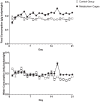Mice do not habituate to metabolism cage housing--a three week study of male BALB/c mice
- PMID: 23505511
- PMCID: PMC3591308
- DOI: 10.1371/journal.pone.0058460
Mice do not habituate to metabolism cage housing--a three week study of male BALB/c mice
Abstract
The metabolism cage is a barren, non-enriched, environment, combining a number of recognized environmental stressors. We investigated the ability of male BALB/c mice to acclimatize to this form of housing. For three weeks markers of acute and oxidative stress, as well as clinical signs of abnormality were monitored. Forced swim tests were conducted to determine whether the animals experienced behavioral despair and the serotonergic integrity was tested using an 8-OH-DPAT challenge. The metabolism cage housed mice excreted approximately tenfold higher amounts of corticosterone metabolites in feces throughout the study when compared to controls. Urinary biomarkers confirmed that these mice suffered from elevated levels of oxidative stress, and increased creatinine excretions indicated increased muscle catabolism. Changes in the core body temperature (stress-induced hyperthermia) and the fur state of the mice also indicated impaired well-being in the metabolism cage housed mice. However, monitoring body weight and feed intake was found misleading in assessing the wellbeing of mice over a longer time course, and the forced swim test was found poorly suited for studying chronic stress in mice in the present setup. In conclusion, the mice were found not to acclimatize to the metabolism cages whereby concern for animal welfare would dictate that mice should be housed in this way for as short periods as possible. The elevated degree of HPA axis activity, oxidative stress, and increased overall metabolism warrant caution when interpreting data obtained from metabolism cage housed mice, as their condition cannot be considered representative of a normal physiology.
Conflict of interest statement
Figures











Similar articles
-
Interactions Between Housing Density and Ambient Temperature in the Cage Environment: Effects on Mouse Physiology and Behavior.J Am Assoc Lab Anim Sci. 2015 Nov;54(6):708-17. J Am Assoc Lab Anim Sci. 2015. PMID: 26632780 Free PMC article.
-
How Do Individually Ventilated Cages Affect the Welfare of Male BALB/c Mice? Comprehensive Assessment of Behavior, Metabolism, and Responses to Acute Painful Stimuli.Brain Behav. 2025 Jun;15(6):e70601. doi: 10.1002/brb3.70601. Brain Behav. 2025. PMID: 40444687 Free PMC article.
-
Acclimatization of mice to different cage types and social groupings with respect to fecal secretion of IgA and corticosterone metabolites.In Vivo. 2012 Nov-Dec;26(6):883-8. In Vivo. 2012. PMID: 23160668
-
Effect of metabolic cage housing on immunoglobulin A and corticosterone excretion in faeces and urine of young male rats.Exp Physiol. 2004 Jul;89(4):427-33. doi: 10.1113/expphysiol.2004.027656. Epub 2004 May 6. Exp Physiol. 2004. PMID: 15131075
-
Housing-related activity in rats: effects on body weight, urinary corticosterone levels, muscle properties and performance.Lab Anim. 2005 Jan;39(1):45-57. doi: 10.1258/0023677052886457. Lab Anim. 2005. PMID: 15703124
Cited by
-
Elucidating the Role of Lipid Rafts on G Protein-Coupled Receptor Function in the Mouse Kidney: An In Vivo Approach.Methods Mol Biol. 2021;2187:187-206. doi: 10.1007/978-1-0716-0814-2_10. Methods Mol Biol. 2021. PMID: 32770507 Free PMC article.
-
Glucocorticoids in relation to behavior, morphology, and physiology as proxy indicators for the assessment of animal welfare. A systematic mapping review.Front Vet Sci. 2023 Jan 6;9:954607. doi: 10.3389/fvets.2022.954607. eCollection 2022. Front Vet Sci. 2023. PMID: 36686168 Free PMC article.
-
Mouse Behavior Tracker: An economical method for tracking behavior in home cages.Biotechniques. 2017 Nov 1;63(5):215-220. doi: 10.2144/000114607. Biotechniques. 2017. PMID: 29185921 Free PMC article.
-
The effects of group and single housing and automated animal monitoring on urinary corticosterone levels in male C57BL/6 mice.Physiol Rep. 2016 Feb;4(3):e12703. doi: 10.14814/phy2.12703. Physiol Rep. 2016. PMID: 26869685 Free PMC article.
-
Urinary Excretion of Iohexol as a Permeability Marker in a Mouse Model of Intestinal Inflammation: Time Course, Performance and Welfare Considerations.Animals (Basel). 2021 Jan 4;11(1):79. doi: 10.3390/ani11010079. Animals (Basel). 2021. PMID: 33406796 Free PMC article.
References
-
- Zhu SW, Yee BK, Nyffeler M, Winblad B, Feldon J, et al. (2006) Influence of differential housing on emotional behaviour and neurotrophin levels in mice. Behav Brain Res 169: 10–20. - PubMed
-
- Ishida H, Mitsui K, Nukaya H, Matsumoto K, Tsuji K (2003) Study of active substances involved in skin dysfunction induced by crowding stress. I. Effect of crowding and isolation on some physiological variables, skin function and skin blood perfusion in hairless mice. Biol Pharm Bull 26: 170–181. - PubMed
-
- Bartolomucci A, Palanza P, Sacerdote P, Ceresini G, Chirieleison A, et al. (2003) Individual housing induces altered immuno-endocrine responses to psychological stress in male mice. Psychoneuroendocrinology 28: 540–558. - PubMed
-
- Manser CE, Elliot H, Morris TH, Broom DM (1996) The use of a novel operant test to determine the strength of preference for flooring in laboratory rats. Lab Anim 30: 1–6. - PubMed
-
- Manser CE, Morris TH, Broom DM (1995) An investigation into the effects of solid or grid cage flooring on the welfare of laboratory rats. Lab Anim 29: 353–363. - PubMed
Publication types
MeSH terms
Substances
LinkOut - more resources
Full Text Sources
Other Literature Sources

